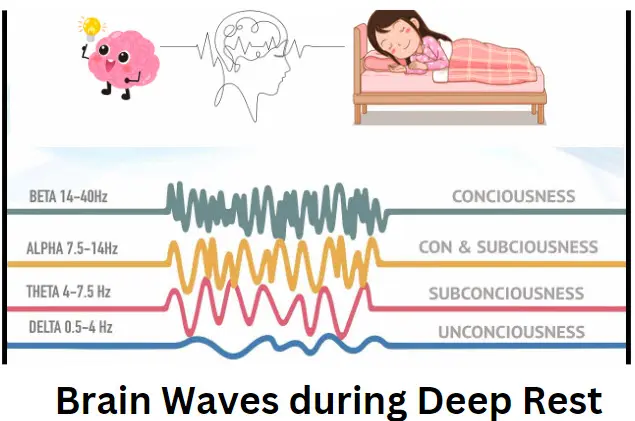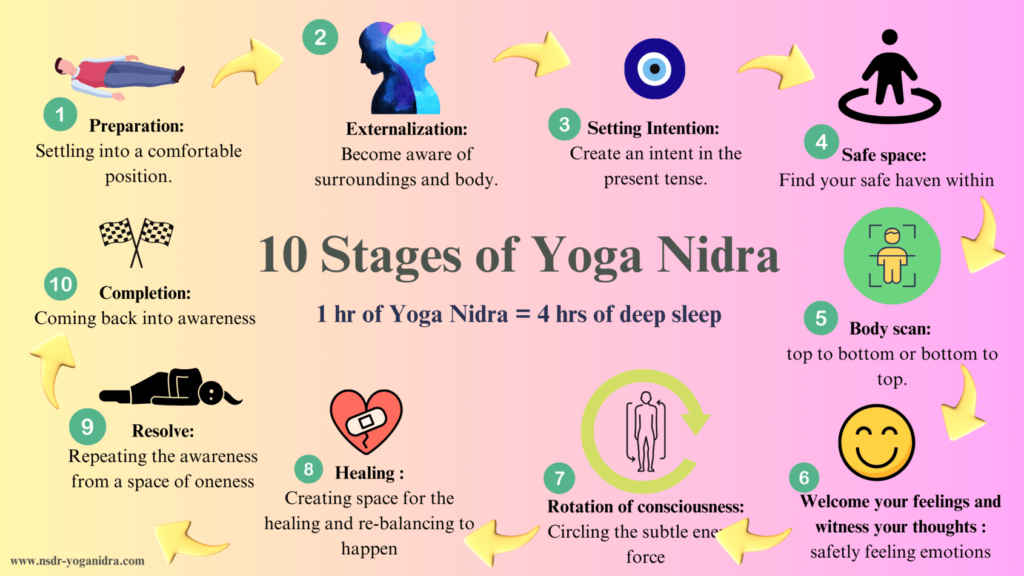Yoga Nidra Overview and Basics
Yoga nidra is a deep relaxation technique that involves rotating awareness through different parts of the body, breath awareness, and visualization. The aim is to withdraw the senses and still the fluctuations of the mind. This induces a deep state of pratyahara which leads to higher meditation
Yoga Nidra Details based on Medicine and Research Papers
Yoga nidra means “yogic sleep.” It is a systematic technique of inducing complete physical, mental, and emotional relaxation while maintaining full consciousness. In simple words you can follow our NSDR Audio-guide where we take you through a body scan and help induce a state of deep relaxation.
According to research by Dr. R. Nagarathna, yoga nidra produces a state similar to sleep but theta brain wave activity remains, indicating deep relaxation with heightened awareness. This state is called pratyahara, where the senses are withdrawn but the mind remains awake.

The Science behind how Yoga Nidra & NSDR Work
NSDR and Yoga Nidra are being used interchangeably. Yoga Nidra is the more anicent term, while NSDR ( Non Sleep Deep Rest) is a term popularized by Neuro Scientist and Podcaster Andrew Huberman. Yoga Nidra practice involves rotating awareness through different parts of the body, breath awareness, and visualization.
Studies show yoga nidra decreases sympathetic nervous system activity (responsible for fight-or-flight stress response) and increases parasympathetic activity (responsible for rest-and-digest relaxation response) . Please review the papers at the end of the article.

In recent years there have been several studies and academic journals showing studies around Yoga Nidra. The complete list of scientific based research on Yoga Nidra can be found in this article.

Benefits of Yoga Nidra & NSDR
Regular practice of Yoga Nidra has been found to reduce tension and anxiety, improve sleep quality, and relieve stress-related diseases like hypertension and diabetes . Yoga nidra’s deep relaxation has also been shown to enhance learning and memory when practiced before sleep. Yoga Nidra sleep benefits are tremendous and 10 minutes of Yoga Nidra equates to 2 to 3 hours of deep sleep.

The Power of Chakra Visualization in Yoga Nidra and Science behind this
Chakra are nothing but Hindi word for Energy Centers. All of us have energy centers. Chakra visualization involves mentally focusing on the location, shape, and color of the 7 chakras aligned along the spine during yoga nidra.

The root chakra at the base of the spine represents security.
The sacral chakra behind the navel represents creativity and sexuality.
The solar plexus chakra represents willpower and self-esteem.
The heart chakra, not surprisingly, represents love and compassion.
The throat chakra governs communication. The third-eye chakra at the brow relates to intuition and imagination. And the crown chakra at the top of the head represents spiritual connection.
Each chakra corresponds to specific emotions, body parts, colors, elements, seed mantras, and symbols. Visualizing the chakras brings awareness to these aspects of our being.
Studies show that during visualization, the electrical conductivity at associated acupressure points increases. This indicates enhanced energy flow to those chakras. Chakra visualization has been found to balance our mental and emotional states and release suppressed traumas and tensions stored within the chakras
There are 10 stages of Yoga nidra
If done correctly 1 hour of Yoga Nidra equates to 4 hours of deep sleep. Below put togther the 10 stages of Yoga nidra. 1.) Preparation, 2.) Externalization, 3.) Setting Intentions, 4.) Find a safe space, 5.) Body Scan , 6.) Welcome your feelings and witness your thoughts, 7.) Rotation of consciousness, 8.) Healing, 9.) Resolve, 10.) Completion

Yoga Nidra and Meditation- How to calm the mind and prepare for Deep Rext
Rotating awareness through the chakras during yoga nidra helps withdraw the senses and calm the mind’s chatter. Focusing on the chakras bridges body and mind, inducing the state of pratyahara which leads to deeper meditation.
Regular yoga nidra and chakra visualization awakens awareness of the dormant areas of the brain, integrating unconscious aspects of oneself and unveiling one’s full creative potential. Research shows the powerful transformative effects of yoga nidra and chakra visualization. By relaxing the body, balancing the emotions, and tapping into our higher spiritual energies, these ancient practices open the doorway to health, self-knowledge, and inner peace.
If you want to know the next-steps and how to take control of your life with Yoga Nidra please visit this article.
References and Academic Journals uses for this article
(1) Nagarathna, R. (n.d.). Yoga nidra and its impact on student’s well being. https://www.mdpi.com/2077-1444/9/9/252
(2) Sarang & Telles, 2006. Oxygen consumption and respiration during and after two yoga relaxation techniques. https://pubmed.ncbi.nlm.nih.gov/16706692/
(3) Kumar, Nagendra, et al (2018). Efficacy of yoga based life style modification program on medication score and lipid profile in type 2 diabetes patients. https://www.ncbi.nlm.nih.gov/pmc/articles/PMC5937758/
(4) Judith, Anodea (2004). Eastern Body, Western Mind: Psychology and the Chakra System.
(5) Motoyama, Hiroshi (2021). Science and the Evolution of Consciousness: Chakras, Ki, and Psi.
(6) Shumsky, Susan G (2003). Exploring Chakras: Awaken Your Untapped Energy.
(7) Saraswati, Swami Satyananda (2015). Yoga Nidra. Yoga Publications Trust.



